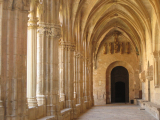Five things you didn't know about Santes Creus
Five things you didn't know about Santes Creus

The oldest Romanesque stained glass in Europe

Santes Creus is the only monastery that has preserved an extensive set of stained glass windows dating from the beginning of the 13th century, the oldest in our environment and one of the few sets of Cistercian glass in all of Europe (the stained glass windows are those of the church transept). The rigour of the regulations of the Cistercian order imposed austerity in colour and the absence of figures as well as a very elaborate geometric design. You can see the difference between these Romanesque stained-glass windows and the large, more colourful stained-glass window on the façade, with small scenes from the life of Jesus and Mary, in the stylistic line of the first Gothic.
The Santes Creus auditorium

Concerts at Santes Creus are performed in the monks' old dormitory due to the architectural and acoustic features that give the music its best sound; at dusk in summer, bats fly to the rhythm of violins: a magical spectacle.
The perfect monastery


The great difference between the monastery of Santes Creus and that of Poblet is the situation of the church with respect to the cloister: in Poblet, it is on the opposite side to
Santes Creus because it does not follow the Sant Bernat de Claravall model. The one in Santes Creus is the monastery that most faithfully reproduces the Bernardine construction plan.
The King in Santes Creus

Per el Gran, was one of the most outstanding rulers of Catalunya. His tomb - one of the two from the transept - remained intact for 700 years; quite a record. His grave, buried in the Santes Creus Royal Monastery since 1285, is one of the few tombs of European royal lineage that had not been exhumed and the only one of the Catalan rulers that had not been robbed. This is the red porphyry bathtub grave. The excavation carried out in 2015 concluded that King Pere was a man of remarkable height for the time, between 175 and 180 cm, with a long face and perhaps blonde hair. After the investigation was concluded, he was returned to his royal bathtub.
The chapiters that speak

The sculptural chapiters in the main cloister of the Santes Creus monastery are among the most curious collections of Gothic sculpture in Europe. Unlike other monasteries that have chapiters decorated with floral motifs, the sculptor Reinard des Fonoll created mythological and even comical animal and human figures: talking sculptures that say all things; each with their own very often evident mystery. Do you dare to discover them?
Notícies relacionades












 Entorn Web · Àrea de Coneixement i Qualitat
Entorn Web · Àrea de Coneixement i Qualitat Oficina de Gestió de Turisme de l’Alt Camp
Oficina de Gestió de Turisme de l’Alt Camp






 turismealtcamp
turismealtcamp turismealtcamp
turismealtcamp turismealtcamp
turismealtcamp